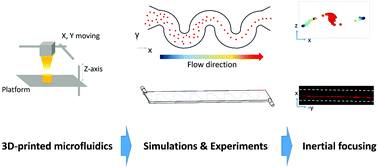当前位置:
X-MOL 学术
›
Soft Matter
›
论文详情
Our official English website, www.x-mol.net, welcomes your feedback! (Note: you will need to create a separate account there.)
Simulation and practice of particle inertial focusing in 3D-printed serpentine microfluidic chips via commercial 3D-printers
Soft Matter ( IF 3.4 ) Pub Date : 2020/02/18 , DOI: 10.1039/d0sm00084a Pengju Yin 1, 2, 3, 4, 5 , Lei Zhao 1, 2, 3, 4, 5 , Zezhou Chen 1, 2, 3, 4, 5 , Zhiqiang Jiao 1, 2, 3, 4, 5 , Hongyan Shi 1, 2, 3, 4, 5 , Bo Hu 1, 2, 3, 4, 5 , Shifang Yuan 5, 6, 7 , Jie Tian 1, 2, 3, 4, 5
Soft Matter ( IF 3.4 ) Pub Date : 2020/02/18 , DOI: 10.1039/d0sm00084a Pengju Yin 1, 2, 3, 4, 5 , Lei Zhao 1, 2, 3, 4, 5 , Zezhou Chen 1, 2, 3, 4, 5 , Zhiqiang Jiao 1, 2, 3, 4, 5 , Hongyan Shi 1, 2, 3, 4, 5 , Bo Hu 1, 2, 3, 4, 5 , Shifang Yuan 5, 6, 7 , Jie Tian 1, 2, 3, 4, 5
Affiliation

|
Inertial focusing of particles in serpentine microfluidic chips has been studied over the past decade. Here, a study to investigate the particle inertial focusing in 3D-printed serpentine microfluidic chips was conducted by simulation and practice. A test model was designed and printed using four commercial 3D-printers. Commercial inkjet 3D-printers have shown the best printing channel resolution of up to 0.1 mm. The force analysis of particle inertial focusing in 3D-printed microfluidic chips with large cross-sectional channels was discussed. Important parameters such as the channel curvature and flow velocity were studied by simulation. The optimal channel curvature and flow velocity are 5.9 mm and 480 μL min−1 (Re: 29.8 and De: 4.49) in the 3D-printed microfluidic chips with 0.2 mm × 0.4 mm cross-sectional channels. Under these optimal conditions, particles were well focused in the middle of the channel. Furthermore, two kinds of cancer cells were focused in these 3D-printed serpentine microfluidic chips under the optimal conditions. We envision that this improved study would provide helpful insights into simulating particle inertial focusing in 3D-printed microfluidic chips and promoting 3D-printed microfluidic chips to commercial production.
中文翻译:

通过商用3D打印机在3D打印的蛇形微流控芯片中进行粒子惯性聚焦的模拟和实践
在过去的十年中,已经研究了蛇形微流控芯片中颗粒的惯性聚焦。在这里,通过模拟和实践进行了研究以研究3D打印的蛇形微流控芯片中的粒子惯性聚焦。设计了测试模型,并使用四台商用3D打印机进行了打印。商用喷墨3D打印机显示出高达0.1毫米的最佳打印通道分辨率。讨论了具有大横截面通道的3D打印微流体芯片中粒子惯性聚焦的力分析。通过仿真研究了重要参数,例如通道曲率和流速。最佳通道曲率和流速为5.9 mm和480μLmin -1(Re:29.8 and De:4.49)在具有0.2 mm×0.4 mm横截面通道的3D打印微流控芯片中。在这些最佳条件下,粒子很好地聚焦在通道的中间。此外,在最佳条件下,将两种癌细胞集中在这些3D打印的蛇形微流控芯片中。我们预想,这项改进的研究将为模拟3D打印的微流控芯片中的颗粒惯性聚焦以及将3D打印的微流控芯片推向商业生产提供有益的见解。
更新日期:2020-03-26
中文翻译:

通过商用3D打印机在3D打印的蛇形微流控芯片中进行粒子惯性聚焦的模拟和实践
在过去的十年中,已经研究了蛇形微流控芯片中颗粒的惯性聚焦。在这里,通过模拟和实践进行了研究以研究3D打印的蛇形微流控芯片中的粒子惯性聚焦。设计了测试模型,并使用四台商用3D打印机进行了打印。商用喷墨3D打印机显示出高达0.1毫米的最佳打印通道分辨率。讨论了具有大横截面通道的3D打印微流体芯片中粒子惯性聚焦的力分析。通过仿真研究了重要参数,例如通道曲率和流速。最佳通道曲率和流速为5.9 mm和480μLmin -1(Re:29.8 and De:4.49)在具有0.2 mm×0.4 mm横截面通道的3D打印微流控芯片中。在这些最佳条件下,粒子很好地聚焦在通道的中间。此外,在最佳条件下,将两种癌细胞集中在这些3D打印的蛇形微流控芯片中。我们预想,这项改进的研究将为模拟3D打印的微流控芯片中的颗粒惯性聚焦以及将3D打印的微流控芯片推向商业生产提供有益的见解。



























 京公网安备 11010802027423号
京公网安备 11010802027423号